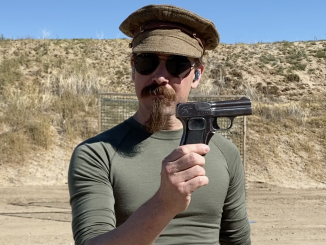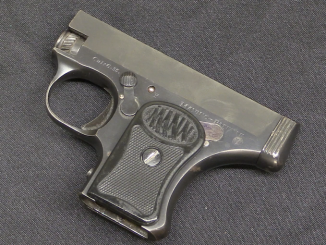When you think about early revolver patent infringement, the name that probably comes to mind is Rollin White. But Sam Colt had more than his share of infringement to deal with as well! Colt’s most important patent was on the linking of the hammer and cylinder, so that cocking the hammer would automatically rotate and index the cylinder (basically, the single action concept). He patented this in the US and throughout Europe around 1836, but his initial business efforts in Paterson, New Jersey were a failure. It wasn’t until the late 1840s that he created a really successful revolver design. By this time, more than half of his patent period had passed, leaving him only until the early 1850s to exploit his legal monopoly on his ideas.
European and American gunmakers were making unlicensed (illegal) copies of his guns from the first Paterson days, although they really took off in popularity with copies of the 1851 Navy model. Colt reacted to this by setting up a licensing fee system and hiring an agent to represent the company at the Liege proofhouse in Belgium, where it was possible to intercept most of the illegitimate guns. Those deemed of sufficient quality could pay 10 Francs and be stamped “Colt Brevete”, rendering them licensed and the manufacturer safe from legal action by Colt.
These Brevete Colt copies are a whole world of interesting collecting by themselves, and one that is ignored by most Colt devotees. In this video, I take a look at 9 different examples to give you an idea of the wide variety of guns that were made both as licensed copies, illicit unlicensed copies, and legal unlicensed copies made after Colt’s patents expired.
If you are interested in learning more about these guns, I strongly recommend the book “Colt Brevete Revolvers” by Roy Marcot and Ron Paxton.
The guns in this video are:
German: https://www.rockislandauction.com/detail/69/240
Belgian Post-1854: https://www.rockislandauction.com/detail/69/237
Nice Belgian Licensed: https://www.rockislandauction.com/detail/69/241
Another Nice Licensed Belgian: https://www.rockislandauction.com/detail/69/242
Engraved Belgian by T. Auguste: https://www.rockislandauction.com/detail/69/246
Weird Grip Belgian: https://www.rockislandauction.com/detail/69/243
Belgian w/ Fake Address: https://www.rockislandauction.com/detail/69/239
Another Belgian, Moderate Quality: https://www.rockislandauction.com/detail/69/238
Russian: https://www.rockislandauction.com/detail/69/244




“Liege proofhouse in Belgium”
To be exact it is Liège not Liege.
“leaving him only until the early 1850s to exploit his legal monopoly on his ideas.”
Does anyone try to dodge this patent, in sense: craft revolver that wouldn’t infringe it?
And what would happen in you copied a copy of a copy of the original Colt revolver? Would that make your gun a fake of a fake of a counterfeit?
Daweo,
The short answer is “yes”; the long answer would fill a book. ^__^
Many of these “dodges” didn’t quite make it and were judged infringements in the end. That didn’t keep folks from trying.
I did not realize that assembling of complete guns using (partly) off-the-shelf (or off the ship) components was a thing as far back 160 years ago. Of course there is a lot of that today, I bet many of the readers of Forgotten Weapons have put together their own rifle or pistol using commercially avail;able parts from multiple manufacturers, and I think that trend might even accelerate as we move further into an era of “mass customization”
One of the biggest problems with these look alike copies was that they often used substandard materials. So, even though they looked like a Colt, they would break and fall apart. These Colt knockoffs started showing up in New York shops at a significantly lower price than the genuine article, there is a famous quote from Sam Colt about this:
“I have seen samples of arms that are infringements upon my Patents they are sed to have been made in Liege & are the most infurnal productions I ever have looked at & better calculated to kill behind [than] before. Under no circumstances shall I permit such arms to be sold where [I] to receive a premeum, or Royalty, of five times the price of one of my [own] make.”
(Above quote from draft letter to A. W. Spies & Company, one of Colt’s New York agents, on 1 February 1853. Quoted from _Samuel Colt: Arms, Art, and Invention_ by Herbert G. Houze et al. (2006) See the chapter in that book “Counterfeits, Infringements, and Competitors” for more details and examples of these arms from Samuel Colt’s personal collection.)
As mentioned in the video, despite the above quote, Colt eventually did make a deal with some of these foreign manufacturers, even providing them with tooling in some cases. The deal that was reached didn’t stop some shops from just faking the roll stamp. Knockoffs were just as much of a problem back then as they are today. ^__^
“Knockoffs were just as much of a problem back then as they are today.”
Or even more. For example why not stamp PATENT (random number)? It is less likely that any average user will go to Patent Office to get information about even its existence.
Since pinfire revolvers already existed in Europe at that time (and presumably the cartridges were widely available as well) it would seem somewhat odd that European gun makers would choose to manufacture obsolete cap & ball revolvers. Could the reason have been because Lefaucheux’s patent enforcement was more severe than Colt’s, or were Colt-style revolvers actually preferred over the pinfire design by many Europeans? Or perhaps counterfeiters were simply hedging their bets by making both kinds, assuming that were the case?
It’s also very interesting that the price of counterfeit cap & ball Colt revolvers can be considerably higher than the price of genuine Lefaucheux pinfire revolvers of the same age.
Buying a pin-fire revolver also meant you were required to buy what was almost certainly proprietary ammunition not shared with other handguns. Have you ever seen a single-shot or double barrel pin-fire weapon?
“Have you ever seen a single-shot or double barrel pin-fire weapon?”
The long-guns generally seem to come that way, although revolvers seem to be the more common handgun. It would certainly have been difficult, though not impossible, to design a magazine-fed gun for such a cartridge with a long -and untouchably dangerous- metal pin sticking out the side.
“difficult, though not impossible, to design a magazine-fed gun for such a cartridge with a long -and untouchably dangerous- metal pin sticking out the side.”
That would be extremely tedious to load – in rim-fire and central-fire weapons it is enough to control where forward of cartridge is – you have to control where forward and upward of cartridge is.
Due to said limitation pin-fire weapons are long gone, excluding some miniature weapons (2mm pinfire), see for example:
http://www.pinfireguns.com
which, generally, are single-shot
Also notice that rim-fire and pin-fire were invented in similar time, have similar drawback of limited pressure contained inside, but rim-fire proved to be usable in magazine fire-arms and thus is still alive, unlike obscure pin-fire.
Such hypothetical weapon would also need to provide to maintain proper direction (upward) when sending cartridge from magazine to chamber to provide that hammer would hit where it is intended to. Designers then found simple solution to problem of capacity: BIGGER CYLINDERS, see photo here: http://guns.wikia.com/wiki/Chaineux_revolver
The hypothetical pin-fire magazine would need to have all the cartridge pins aligned between two rails, keeping them in perfect orientation as the cartridges slid toward the firing chamber.
Another proposed improvement: Instead of the standard round cartridge, having a hexagonal or octagonal cartridge (and chamber) would allow for keeping the cartridge properly aligned throughout its travel without putting pressure on the cartridge’s protruding pin.
While not the perfect system by any means, the pin-fire could certainly have been developed into a magazine-fed manual or auto-loading firearm — or even conceivably a belt-fed machine gun.
It would also have been interesting to see how far cap-and-ball revolver technology could have evolved, had fixed ammunition not taken over. (Perhaps loaded cylinders fed via magazines and basically used as “six shot cartridges”?)
“cap-and-ball revolver technology could have evolved”
It is not revolver, but US Patent 36836 A:
https://www.google.com/patents/US36836
titled Improvement in revolving battery-guns describe rapid-fire percussion weapon.
“pin-fire(…)single-shot”
Yes, there exist pin-fire shotshell and thus pin-fire shotguns, see lists in muncion:
http://municion.org/lefaucheux/lefaucheux.htm
Lefaucheux did made some long weapon with pinfire system
Patent 117350 of 5th march 1877 (France) and 41621 of 15th march 1877 (Belgium)
http://s144812367.onlinehome.fr/wp-content/uploads/2016/06/ak-1.jpg
Then LF70 as a 12 gauge shotgun
http://s144812367.onlinehome.fr/wp-content/uploads/2016/05/12-copie.jpg
And various systems using pinfire shotgun ammunition
http://s144812367.onlinehome.fr/category/armes/fc
C.G.,
Thanks for those links, that last one especially. I haven’t seen many pinfire long arms in the U.S. outside of museum cases. (In fact, I’ve only personally handled two double-barreled pinfire shotguns in my career.)
This website is made buy a specialist who has already published one or two reference book about Lefaucheux productions. I hope/bet he knows his subject !
watching the Colt Brevet video was interesting and informative I have a 25cal Brevet a very interesting little thing I could find nothing out about it even when I went to the Leige arms museum.
But the video talk helped so I now know it it was made between 1851 and 1854 if only I new it’s history what a tale it might tell.
Ian, you make one of your rare errors here. The trigger guard and backstrap of many Colt percussion revolvers was originally silver plated, and it wore off relatively quickly. I own an original 1849 Pocket which clearly has traces of silver left in protected areas, but would appear to be brass at a quick, uninformed glance.
That one gun had a silver plated brass/gunmetal trigger guard and grip strap and you commented it was brass plated, and the brass was wearing off. Backwards, silver plated, and mostly there, brass peaking through in high wear edges.
And my second gen Colt made 1862 Navy has a silver back strap and trigger guard frame, and I bought it new, and the silver is still in good condition.
Love your videos and you so rarely make an error…it’s kinda fun to find an area where I know a bit more than even a real expert like you does.
I have had two revolving rifles. 1)A Colt,36cal, non-military, Vanier/tang sight,pristine,serial#15.2)A presumed Lafausch pinfire,cal.unknown which my Dad bought for me for one pound($2.80)when we lived in Whaddon,nrBletchley,Bucks(Milton Keenes)1952-56.Dad was American Editor-in-Chief of the 410 tons of German documents(Foriegn office)stored in the manor house. Watch “Vergangenheit” in The Crown series. Folding trigger,pinfire revolvers were 10shillings($1.40).
You need to understand whether such toys are legal in your region, in some States of America even a Flaubert pistol must be registered. On the other hand, small models in the scale of 1 to 4 received crazy development. Exp: https://wpolah.com/product/2mm-pinfire-gun-colt-1873-peacemaker-revolver-scale-1-4-metal-scale-model/